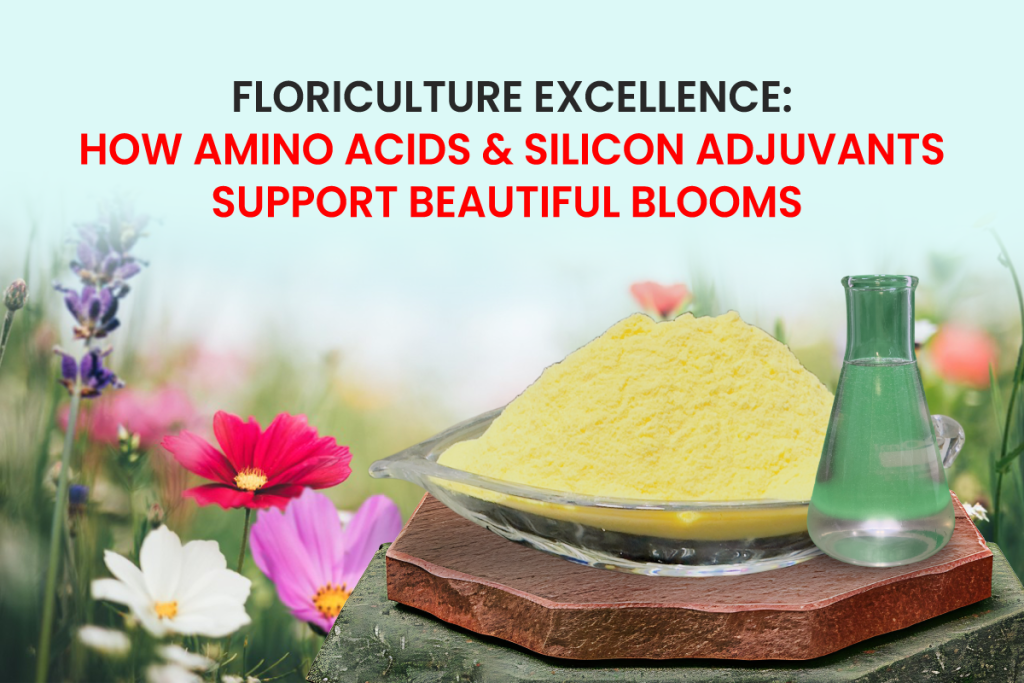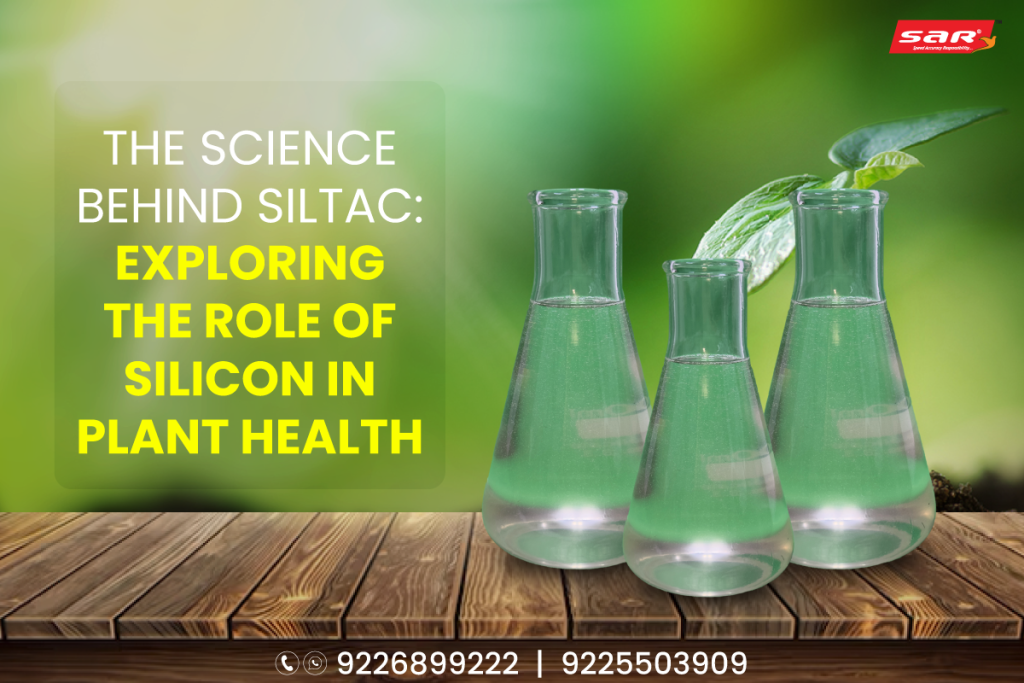
Floriculture, the science and art of growing flowering plants is an increasingly high-tech business with many different sub-disciplines including genetics. As we seek more color and longevity from our blooms, this innovation has also extended to the way we plant nutritionally protect them — enter amino acids & silicon adjuvants. They improve the health and beauty of flowers resulting in better quality and a longer shelf life. Amino Acids & Silicon Adjuvants Key to Floriculture Excellence — Beautiful and Hardy Blooms is the Goal
The Importance of Amino Acids in Floriculture
Amino acid, which are so called because of their rich diversity in metabolic processes for plants and other organisms (living beings), represent a group of organic compounds. Amino acid plays an indispensable role in diversified physiological, and metabolic processes related to the growth pattern of flower quality, color size, and substantial health improvement in floriculture.
1. Enhanced Nutrient Uptake:
Amino acids increase nutrient uptake emphasizing nitrogen, phosphorus and potassium needed as it relates to flower growth. They work as chelating agents binding with important minerals and making them mobile in the plant. This process in turn leads to better nutrient availability, producing healthier and more colorful flowers.
2. Stress Resistance:
While floriculture usually is the growing of flowers under controlled environments and plants may come under stress due to various conditions like temperature, light intensities, or water. Amino acids reduce the effect of this stress by inducing the production of some stress-related proteins, thus increasing plant resistance against that kind of stress. That means with less production cost cut flowers have more robustness and are better at maintaining their freshness in tougher conditions.
3. Improved Photosynthesis:
Photosynthesis is a process that plants use to convert light energy into chemical energy, which can be used as fuel and feed their growth. It could have been previously realized that the compounds known as amino acids had been indispensable for this technique with their function of growing chlorophyll, which permitted plants to take in mild. Shades of bright coloration, contributed by the increased activation of chlorophyll synthesis pathways affect plant processes overall in favoring speedier growth and heartier colorful blooms.
4. Quick Growth and Blooming:
They also play a vital role in the synthesis of growth hormones such as auxins, gibberellin & cytokinin which control different factors for plant development like cell division elongation and flowering. In short, amino acids work in favor of plant growth and flowering by inducing the production of these hormones at a faster rate, thus advancing the bloom cycle. By doing so more flowers are formed sooner on average, together creating a better yield (Figures 1-5) compared to control plants treated with no A.A.s applications.
5. Enhanced Flower Quality:
The entire color, petal shape, and aroma of flowers are affected by amino acids. These metabolites, including flavonoids and anthocyanins) help produce bright colors and aromatic compounds that attract pollinators to flowers. Amino acids also help the structural integrity of flowers, reducing wilting and prolonging their vase life.
Silicon Adjuvants: A Game-Changer in Floriculture
While not strictly required for most plant species, silicon has emerged as an important element in the promotion of robust health and vigor. Among the various applicational approaches, silicon adjuvants minimize bloom-related stress factors that are induced by floricultural crops enhancing the quality and physiological health of blooms.
1. Strengthened Plant Structure:
Silica is a well-documented preservative of cell walls, and it makes them harder–hard to slice through with a scalpel or tear. –making plants less easily sheared. In floriculture, that means stiffer stems and leaves with additional turgor pressure to support the large, heavy blooms. Silicon adjuvants can also be used to treat flowers for them to stay up (did not lodging) and last post-harvest longer.
2. Increased Disease Resistance:
All floricultural crops are potentially subject to attack by pathogens-both fungal and bacterial. It stimulates the formation of phytoalexins and improves the natural immunity of plants to disease. Silicon is also a barrier within plant tissues for pathogens, making it harder to infect the plant. This double benefit leads to better disease resistance in the plants.
3. Improved Water Management:
Water management is one of the important aspects of floriculture growth, particularly for an area that possesses limited water resources. Silicon adjuvants are also helping in saving water resources by reducing transpiration rates and increasing the wetness-holding capacity of plants. As a result, they hydrate better, and the risk of drought stress is reduced — resulting in brighter, healthier-looking flowers even on dry days.
4. Enhanced Stress Tolerance:
Silicon plays a vital role in improving plant resistance to abiotic stresses i.e. low and high temperatures, salinity stress, drought, and heavy metal toxicity as well. Silicon adjuvants help plants keep their growth and flowering potential by mitigating the effects of these stressors. In floriculture, environmental conditions change significantly, and any stress caused to the plant deteriorates flower quality.
5. Increased Flower Longevity:
Long-lasting blooms are one of the best traits in floriculture. One of the ways that silicon benefits crops is by delaying senescence, so a plant takes longer to die after it has reached its climax in nutrient accumulation. The silicon helps stabilize cell membranes and reduces oxidative damage, allowing them to be an eye-catching bunch in your local store if not the entire city.
Synergistic Effects of Amino Acids and Silicon Adjuvants
Amino acids and silicon adjuvants on their own provide important advantages for floricultural crops, but when applied together they have synergistic effects that improve bloom quality and plant health.
1. Nutrition and Defense Against Maladies:
Amino acids enhance the absorption and metabolism of nutrients, silicon makes plant structure stronger and more pest resistant. Combined, they offer a holistic solution to plant nutrition and protection—providing flowers with the nutrients required for growth while simultaneously protecting them from environmental stressors.
2. Better Growth and Development:
The combination of growth-promoting aspects along with stress tolerance from silicon results in faster growth and more vigorous flowering. Larger, more brightly colored blooms are the result — unsurpassed in sturdiness by anything else out there.
3. Improved Aesthetic Appeal:
Therefore, improving more of color and smell through providing amino acids indirectly to the plant system will result in the best colorful fruits with more fragrance along the structural support by silicon-made flowers long-lasting. This combination is particularly important in commercial floriculture, where the appearance of flowers holds priority.
4. Prolonged Bloom Duration:
Amino acids and silicon share the fact that they extend flower life, albeit in a different form. Amino acids help in the metabolic processes which maintain bloom strength whereas silicon helps avoid premature aging and reduces physical damage. Both works together to keep the flowers looking good and sellable as long as possible.
5. Sustainable Floriculture Practices
Amino acid and silicon adjuvants are in line with the sustainable floriculture production environment thanks to the diminishing of the chemical fertilizers from regular use, farmers can customize their fertilizer more precisely due to cutting down on spraying volume needed for pesticide application. By improving the plant’s natural intake of nutrients and disease resistance mechanisms grown with a sustainable reduction in chemical residuals into healthier crops.
Conclusion: Cultivating Excellence in Floriculture
High-quality floriculture needs to be supported by a complete technological package, including nutritional and protective solutions of different levels. The combination of amino acids and silicon adjuvants: This additive is an effective way to combine growth, health, and beauty for flowers. These products help ensure that flowers reach their maximum potential because when roots better access nutrients, the plant is more structured and able to handle stress, and bloom life is enhanced.
By introducing amino acids and silicon surfactants into their cultivation methods, floriculturists looking to raise flowers of the highest quality simply activate improved conditions for success. To sum up, a single flower additive represents an excellent opportunity not only for commercial production but also for private enjoyment through the benefits of the more vibrant flowers and longer-lasting aromatic bouquet – to please our junkyard self-esteem fanbase.

